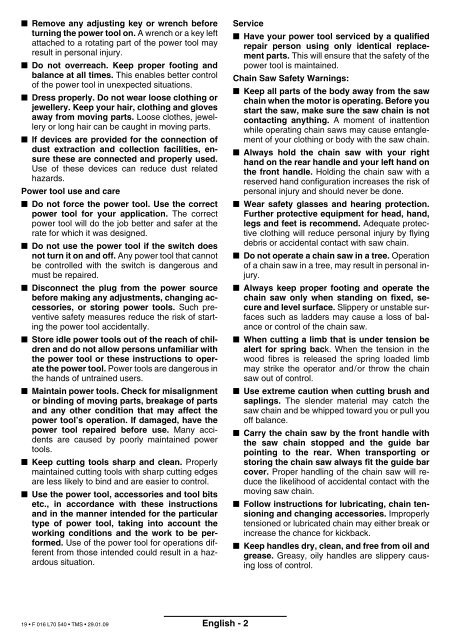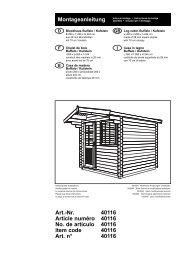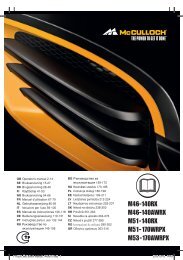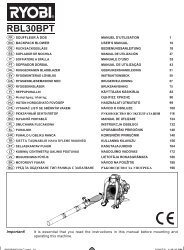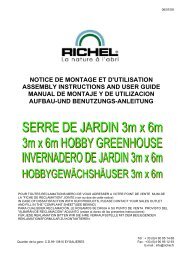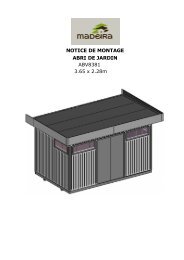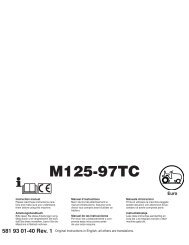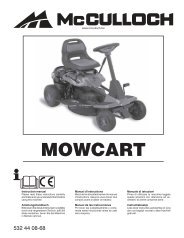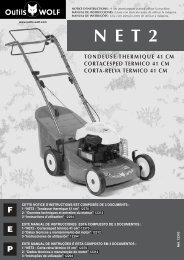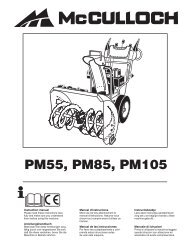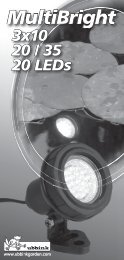AKE 30 S AKE 35 S AKE 40 S - Plantes et Jardins
AKE 30 S AKE 35 S AKE 40 S - Plantes et Jardins
AKE 30 S AKE 35 S AKE 40 S - Plantes et Jardins
Create successful ePaper yourself
Turn your PDF publications into a flip-book with our unique Google optimized e-Paper software.
■ Remove any adjusting key or wrench before<br />
turning the power tool on. A wrench or a key left<br />
attached to a rotating part of the power tool may<br />
result in personal injury.<br />
■ Do not overreach. Keep proper footing and<br />
balance at all times. This enables b<strong>et</strong>ter control<br />
of the power tool in unexpected situations.<br />
■ Dress properly. Do not wear loose clothing or<br />
jewellery. Keep your hair, clothing and gloves<br />
away from moving parts. Loose clothes, jewellery<br />
or long hair can be caught in moving parts.<br />
■ If devices are provided for the connection of<br />
dust extraction and collection facilities, ensure<br />
these are connected and properly used.<br />
Use of these devices can reduce dust related<br />
hazards.<br />
Power tool use and care<br />
■ Do not force the power tool. Use the correct<br />
power tool for your application. The correct<br />
power tool will do the job b<strong>et</strong>ter and safer at the<br />
rate for which it was designed.<br />
■ Do not use the power tool if the switch does<br />
not turn it on and off. Any power tool that cannot<br />
be controlled with the switch is dangerous and<br />
must be repaired.<br />
■ Disconnect the plug from the power source<br />
before making any adjustments, changing accessories,<br />
or storing power tools. Such preventive<br />
saf<strong>et</strong>y measures reduce the risk of starting<br />
the power tool accidentally.<br />
■ Store idle power tools out of the reach of children<br />
and do not allow persons unfamiliar with<br />
the power tool or these instructions to operate<br />
the power tool. Power tools are dangerous in<br />
the hands of untrained users.<br />
■ Maintain power tools. Check for misalignment<br />
or binding of moving parts, breakage of parts<br />
and any other condition that may affect the<br />
power tool’s operation. If damaged, have the<br />
power tool repaired before use. Many accidents<br />
are caused by poorly maintained power<br />
tools.<br />
■ Keep cutting tools sharp and clean. Properly<br />
maintained cutting tools with sharp cutting edges<br />
are less likely to bind and are easier to control.<br />
■ Use the power tool, accessories and tool bits<br />
<strong>et</strong>c., in accordance with these instructions<br />
and in the manner intended for the particular<br />
type of power tool, taking into account the<br />
working conditions and the work to be performed.<br />
Use of the power tool for operations different<br />
from those intended could result in a hazardous<br />
situation.<br />
19 • F 016 L70 5<strong>40</strong> • TMS • 29.01.09<br />
English - 2<br />
Service<br />
■ Have your power tool serviced by a qualified<br />
repair person using only identical replacement<br />
parts. This will ensure that the saf<strong>et</strong>y of the<br />
power tool is maintained.<br />
Chain Saw Saf<strong>et</strong>y Warnings:<br />
■ Keep all parts of the body away from the saw<br />
chain when the motor is operating. Before you<br />
start the saw, make sure the saw chain is not<br />
contacting anything. A moment of inattention<br />
while operating chain saws may cause entanglement<br />
of your clothing or body with the saw chain.<br />
■ Always hold the chain saw with your right<br />
hand on the rear handle and your left hand on<br />
the front handle. Holding the chain saw with a<br />
reserved hand configuration increases the risk of<br />
personal injury and should never be done.<br />
■ Wear saf<strong>et</strong>y glasses and hearing protection.<br />
Further protective equipment for head, hand,<br />
legs and fe<strong>et</strong> is recommend. Adequate protective<br />
clothing will reduce personal injury by flying<br />
debris or accidental contact with saw chain.<br />
■ Do not operate a chain saw in a tree. Operation<br />
of a chain saw in a tree, may result in personal injury.<br />
■ Always keep proper footing and operate the<br />
chain saw only when standing on fixed, secure<br />
and level surface. Slippery or unstable surfaces<br />
such as ladders may cause a loss of balance<br />
or control of the chain saw.<br />
■ When cutting a limb that is under tension be<br />
alert for spring back. When the tension in the<br />
wood fibres is released the spring loaded limb<br />
may strike the operator and/or throw the chain<br />
saw out of control.<br />
■ Use extreme caution when cutting brush and<br />
saplings. The slender material may catch the<br />
saw chain and be whipped toward you or pull you<br />
off balance.<br />
■ Carry the chain saw by the front handle with<br />
the saw chain stopped and the guide bar<br />
pointing to the rear. When transporting or<br />
storing the chain saw always fit the guide bar<br />
cover. Proper handling of the chain saw will reduce<br />
the likelihood of accidental contact with the<br />
moving saw chain.<br />
■ Follow instructions for lubricating, chain tensioning<br />
and changing accessories. Improperly<br />
tensioned or lubricated chain may either break or<br />
increase the chance for kickback.<br />
■ Keep handles dry, clean, and free from oil and<br />
grease. Greasy, oily handles are slippery causing<br />
loss of control.


